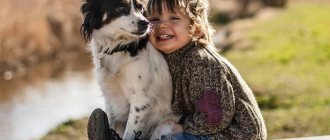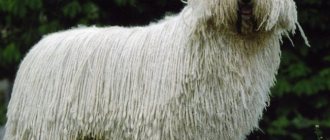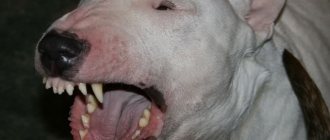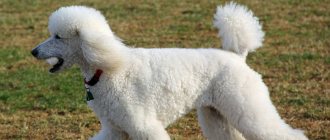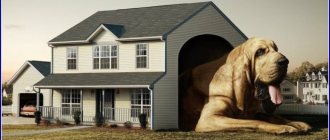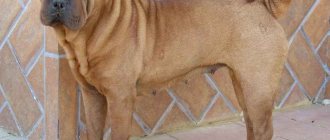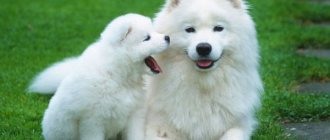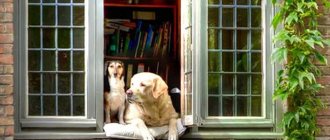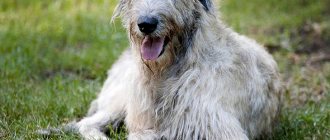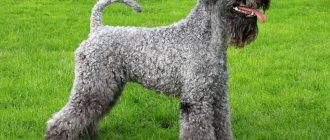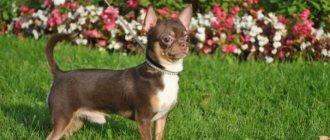Natural and artificial selection
In the selection of dog breeds, there are two types of selections by which it is carried out. As the title suggests, they are called natural and artificial. The first is not carried out in modern breeding, because it implies the natural death of unsuccessful breed specimens without human intervention.
We will talk about artificial selection in dog breeding in more detail.
Kava-poo-chon
This is one of the youngest breeds, developed by crossing the Cavalier King Charles Spaniel, Toy Poodle and Bichon. The breeders' plans included obtaining a small decorative dog with good health and hypoallergenic coat.
Kava-poo-chon is considered a very rare and expensive animal. Despite the fact that this breed has not yet been officially recognized, it has found its connoisseurs among ordinary owners.
The essence of artificial selection
What determines the effectiveness of artificial selection? There are a lot of factors here: from environmental conditions to the number of alleles responsible for the formation of a certain trait.
Features of dog selection are based on the genetic essence of artificial selection. Animals are selected based on the following characteristics:
- Against the dominant gene.
- For a dominant gene.
- Against a recessive gene.
- By a recessive gene.
- In favor of heterozygotes.
- Against heterozygotes.
Dominant gene
We know that there are genes that take precedence over all others. And if you need to get animals with a certain color, then selection during dog breeding is carried out for a dominant gene. It is necessary to have alleles responsible for one or another coat color in both producers. This is why they mate the main sires with subsequent analysis of the work of genetics on the resulting offspring.
Against heterozygotes
It is used quite rarely, only when working with certain breeds of dogs. One of these is poodles. For example, it is necessary to obtain silver-colored offspring. Most representatives of the breed are dark gray in color, which is formally considered silver. But this is the wrong approach: such individuals must be discarded from breeding dogs with true silver color.
Thus, such selection in dog breeding is used when heterozygotes have a phenotype or complementarity that is completely undesirable for certain individuals.
Russian salon dog
These decorative dogs appeared about fifteen years ago. They were bred by domestic livestock specialist Yu. A. Lakatosh by crossing a Yorkshire terrier, a pug and a Belgian griffin. Like any other new dog breeds in Russia, these miniature animals quickly gained popularity. They are ideal for keeping in a city apartment and have an open, easy-going character.
Unlike other decorative dogs, they have a powerful build and strong bones. On the rounded, short-muzzled head there are high-set ears, giving them a touching appearance. The animal's body is covered with long flowing hair, which requires careful care and regular grooming. The height of adult individuals is 18-28 cm. The weight of such a dog varies between 1.8-3.5 kg.
The Russian salon dog is easy to train, quickly remembers new commands and rarely shows aggression. This tiny pet gets along well with children and is able to get along in the same area with other pets.
Let's talk about breeding
Breeding and selection of dogs are quite complex things that require very deep knowledge on the part of the breeder (breeder). But if artificial selection and heredity were mentioned above, then it is impossible not to mention breeding methods. Let's talk about this very briefly.
There are two methods: interbreed and purebred. To breed new animals, the first method is used; to consolidate certain forms within the breed, of course, the purebred method of breeding is used.
Purebred breeding can be unrelated (outbred), inbred (related), linear and interlineal (outcross).
Outbred breeding
If we don’t go into all the details, but to put it briefly, outbred breeding is the mating of unrelated animals. In other words, there are no common ancestors in their pedigrees even in the most distant generations. Nowadays outbred breeding is very popular: local bitches are mated with foreign exported males. The resulting daughters are again bred to imported males, and so on from generation to generation.
Male representatives of the breed obtained as a result of this breeding method rarely take part in matings.
Dachshund
What happens if you build a bridge that is longer than its strength allows? Such a bridge can collapse, and the dachshund's musculoskeletal system presents exactly this problem.
Originally bred to hunt small, often burrowing prey, dachshunds, whose name means "badger dog" in German, are highly prone to serious back problems given their long build coupled with very short limbs. Colloquially known as sausage dogs, they often suffer from a terrible condition known as intervertebral disc disease.
The Dachshund is a breed that is so prone to spinal problems that 25% of Dachshunds born later become victims of devastating spinal diseases. Ruptured discs, prolapsed discs, herniated discs, protruding discs, and slipped discs are just some of the types of disc damage that occur in Dachshunds. Results? Catastrophic! The result is pressure on the spinal cord, leading to pain, associated permanent injury and paralysis. Surgery may help, but often the end result of intervertebral disc disease in most affected dachshunds is euthanasia.
Inbred breeding
This is inbreeding, used to consolidate certain qualities, as well as the exterior, of representatives of the breed. They use it often, but what they want doesn’t always turn out as expected. The method is dangerous because you can get not only an outstanding dog, but also a complete freak. But it cannot be denied that inbred breeding has always been used to obtain pure lines.
There are several degrees of it:
- Close inbreeding: mating between father and daughter, mother and son, half-siblings, brother and sister, grandmother and grandson, granddaughter and grandfather.
- Close relationship: both dogs that are going to be bred have a common ancestor in the 4th generation.
- Moderate relatedness: the presence of a common ancestor in the IV-VI generations.
Review of the most popular breeds of Russian dogs
A large number of Russian dog breeds are known in the world. Many of them have been recognized by the International Canine Federation. A list of the most prominent animal representatives is presented below.
Alabai
Alabai was developed in the USSR in the 20th century. Representatives of this breed reach 65-70 cm at the withers. The life expectancy of the animal ranges from 12 to 15 years. The minimum weight that adult Alabais must gain is 45-50 kg, depending on gender.
This is not a fighting dog, although it is often used for this purpose. The animal was bred to guard and protect humans. The pet is quite independent, fearless, but not aggressive unless the occasion requires it.
East European Shepherd
The East European Shepherd was bred for service on the borders. It was supposed to be resistant to harsh conditions. For selection, German Shepherd and Laika, as well as Russian Great Dane, were used.
Representatives of this breed are larger and more resilient than German shepherds. At the same time, they are devoted not only to border guards, but also to ordinary people. After the collapse of the Soviet Union, their popularity declined greatly, but the species did not disappear.
East European Shepherd
West Siberian Laika
This is a sociable representative of the canine family, which depends on humans and constantly requires his attention. The animal does not tolerate loneliness well and becomes stressed. It was developed in the Soviet Union in the 20th century.
West Siberian Laika
Caucasian Shepherd Dog
The second name of the Caucasian Shepherd is wolfhound. Representatives of this breed are distinguished by their large size, strength and large muscles. The height of animals at the withers ranges from 64 to 68 depending on gender. The lower weight limit is 45-50 kg.
Caucasian Shepherd Dogs have an elongated, massive body with a wide head and a compact muzzle. There are individuals with both short and long hair. Most often the color is gray with red spots. However, the shade of the coat can range from cream to brown.
Note! If raised incorrectly, an animal may show aggression towards a stranger. If enough attention was paid to early socialization, then such a character trait should disappear.
Caucasian Shepherd Dog
Moscow guard dog
For the selection of the Moscow guard dog the following were used:
- wolfhounds;
- Saint Bernards;
- piebald hounds.
Pets of this breed have collected the best qualities of their ancestors. They look fierce in appearance, but are quite unpretentious and hardy. If brought up incorrectly, they experience hostility towards strangers. At the same time, they love their owner and family members endlessly.
Moscow guard dog
Russian hound
The hound is considered a native Russian breed. The exact time of selection is unknown, but the available data indicate that it was bred in the 5th-6th century. Work on the breed was carried out in the 19th century. At the moment, the Russian hound is used for hunting hares and foxes.
A medium-sized dog whose weight ranges from 25-30 kg. The height of the animal at the withers ranges from 55 to 65 cm. Russian hounds are strong and muscular, distinguished by a rather small head compared to the background of the body. A distinctive feature is the hanging ears of a triangular shape.
Note! Representatives of this breed are friendly and active. However, with improper training and lack of education, they can experience aggression towards other hounds.
Russian hound
Russian piebald hound
One of the most ancient dog breeds bred in the former Soviet Union is the piebald hound. They were used to corral hare, fox, roe deer, wolf and wild boar. At the moment the breed is considered extinct.
Russian piebald hound
Russian greyhound
This breed is one of the most famous. Important characteristics of the animal include good sprinting skills, endurance and an easy-going nature. Pets are good for hunting.
Russian greyhound
Russian hunting spaniel
The Russian hunting spaniel is distinguished by its excitement, speed, and easy adaptation to city life. Representatives of this breed are tireless, love to swim, and are good trackers. At the same time, a spaniel can become a good-natured companion who can easily find a common language with children.
Russian hunting spaniel
Russian toy terrier
The breeding of Russian Toy Terriers began in the 20th century. The goal of the scientists of the Soviet Union was to create a decorative breed of dogs, like the English toy terriers. The Russian Canine Federation registered the animal in 2021. It was recognized in the world a little later.
The photograph shows small dogs whose height at the withers does not exceed 28 cm. The dogs have lean muscles, thin and high legs. The main feature in its external characteristics is its large ears, which are shaped like a candle flame. At the moment there are two types of Russian Toy Terriers:
- Smooth-haired. They have short, shiny fur that fits tightly to the body of the animal.
- Long-haired. This is a Russian dog with fur about 3-5 cm long. It can be wavy or straight.
Animals are presented in several shades. The color can be black, brown, fawn, red. Representatives of this breed are active dogs, they are very loyal to their owner and miss him.
Important! The dog has a weak psyche, and therefore should not be kept in a house with small children.
Russian toy terrier
Black Russian Terrier
The following dog breeds were used for breeding the Black Russian Terrier:
- wolfhound;
- Newfoundland;
- Rottweiler;
- Giant Schnauzer.
Breeding began on the orders of Stalin, who wanted to get a dog that would be a good watchman and easily endure the cold. Despite the purposes for which representatives of this breed were intended, these are kind creatures. With proper upbringing, they become good companions and nannies for small children.
Black Russian Terrier
Siberian Husky
The Siberian Husky is considered a sled dog, but is often purchased as a companion. In appearance, the animal seems light and compact, thanks to its thick, short fur. The dog has erect triangle ears. A distinctive feature of the animal is its eyes, the color of which can be any. Representatives of this breed are often born with heterochromia.
Husky is not suitable for service because the animal is too independent. The advantage over other breeds is their harmlessness and friendliness. Huskies are often kept as a nanny for small children in the home.
Siberian Husky
Russian dogs have always been popular due to a number of qualities that are inherent in them. When choosing a pet, you need to familiarize yourself in detail with the characteristics of the animal and the characteristics of the breed. You can get most of the information from breeders and at specialized exhibitions.
